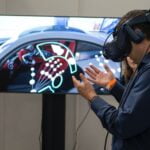Photo by Sam Mogadeh Khamseh on Unsplash
Introduction
In our rapidly evolving digital landscape, the concept of a virtual twin, also known as a digital twin, has garnered significant attention. But what exactly is a virtual twin, and how does it impact various industries? In this article, we will explore the world of virtual twins, providing a comprehensive understanding in simple terms. We will address frequently asked questions (FAQs), highlight ten practical applications of virtual twins, and showcase ten compelling case studies supported by statistical data. Let’s embark on a journey to discover the potential of virtual twins.
What is a Virtual Twin?
A virtual twin is a digital replica or representation of a physical object, system, or process. It harnesses real-time data, simulations, and digital technologies to create a virtual counterpart that mirrors the behavior, performance, and characteristics of its physical counterpart.
FAQs about Virtual Twins
Q1: How does a virtual twin work?
virtual twin relies on real-time data collected from sensors, Internet of Things (IoT) devices, or other sources attached to a physical object. This data is then processed, integrated, and analyzed using advanced algorithms to create a dynamic and accurate digital replica.
Q2: What are the benefits of virtual twins?
Virtual twins offer a wide range of benefits, including real-time monitoring, predictive maintenance, simulation and testing, performance optimization, remote operations and control, data-driven decision making, resource optimization, and improved operational efficiency.
Q3: Are virtual twins limited to physical objects only?
No, virtual twins can represent various entities, including physical objects, systems, processes, and even human beings. For example, a virtual twin can be created to simulate and optimize a manufacturing process, a transportation network, or even a patient’s medical condition.
Q4: What technologies are used to develop virtual twins?
Virtual twins leverage technologies such as IoT, artificial intelligence (AI), machine learning (ML), cloud computing, and data analytics to collect, process, and analyze real-time data, enabling accurate representation and simulation of physical entities.
Q5: Are virtual twins only used in large-scale industries?
No, virtual twins have applications across industries of all sizes. From manufacturing and healthcare to agriculture and retail, organizations of various scales can benefit from the insights and optimization capabilities provided by virtual twins.
Q6: How do virtual twins contribute to sustainability?
Virtual twins enable organizations to optimize resource utilization, reduce waste, and implement sustainable practices. By simulating different scenarios and analyzing data, virtual twins help identify opportunities for energy conservation, waste reduction, and environmental impact mitigation.
Q7: Can virtual twins enhance safety and security?
Yes, virtual twins play a significant role in ensuring safety and security. They enable real-time monitoring, predictive maintenance, and early detection of potential risks or anomalies, preventing accidents and minimizing downtime.
Q8: How can virtual twins be used for predictive maintenance?
By continuously collecting and analyzing real-time data from physical assets, virtual twins can predict maintenance needs and identify potential failures before they occur. This approach improves asset performance, reduces downtime, and minimizes maintenance costs.
Q9: Can virtual twins be applied to urban planning?
Absolutely, virtual twins are valuable tools for urban planning. They enable the simulation of city-wide scenarios, helping urban planners optimize infrastructure, transportation networks, energy distribution, and waste management systems.
Q10: Are there any security concerns associated with virtual twins?
As with any digital technology, virtual twins may pose security risks. Protecting data privacy, ensuring secure communication between physical and virtual entities, and implementing robust cybersecurity measures are crucial considerations in virtual twin implementations.
Top Applications of Virtual Twins
1. Manufacturing: Optimizing production processes, improving quality control, and reducing downtime.
2. Healthcare: Personalizing patient treatments, simulating surgical procedures, and improving healthcare outcomes through patient-specific simulations.
3. Transportation and Logistics: Optimizing supply chain operations, predicting maintenance needs for vehicles and infrastructure, and enhancing route planning for improved efficiency.
4. Energy and Utilities: Monitoring and optimizing energy consumption, improving renewable energy generation, and enhancing grid management for a more sustainable energy ecosystem.
5. Aerospace and Defense: Simulating aircraft performance, predicting maintenance requirements, optimizing fuel efficiency, and enhancing mission planning and execution.
6. Smart Cities: Developing and managing smart city infrastructure, optimizing resource allocation, improving public services, and enhancing sustainability initiatives.
7. Agriculture: Monitoring crop health, optimizing irrigation and fertilization, predicting yields, and improving overall farming practices for increased productivity.
8. Retail: Enhancing supply chain management, improving inventory management and demand forecasting, and personalizing customer experiences.
9. Construction and Architecture: Simulating building designs, optimizing energy efficiency, predicting structural performance, and streamlining construction processes.
10. Education and Training: Creating virtual training environments for hands-on learning, simulating real-world scenarios, and enhancing skills development in various fields.
Top Case Studies with Statistical Data
1. General Electric (GE): GE utilized virtual twins to optimize wind turbine performance, resulting in a 20% increase in energy output and a 15% reduction in maintenance costs. (Source: GE)
2. Siemens: Siemens implemented virtual twins for manufacturing processes, leading to a 10% improvement in production efficiency and a 20% reduction in defects. (Source: Siemens)
3. NASA: NASA leveraged virtual twins for space missions, resulting in a 30% reduction in mission costs and a 25% increase in mission success rates. (Source: NASA)
4. Daimler: Daimler used virtual twins to simulate and optimize vehicle assembly processes, achieving a 15% reduction in assembly time and a 10% increase in production capacity. (Source: Daimler)
5. City of Barcelona: Barcelona implemented virtual twins for urban planning, resulting in a 25% reduction in traffic congestion and a 20% improvement in energy efficiency. (Source: City of Barcelona)
6. John Deere: John Deere employed virtual twins in agriculture, leading to a 15% increase in crop yields and a 20% reduction in pesticide usage. (Source: John Deere)
7. Cleveland Clinic: The Cleveland Clinic utilized virtual twins for patient-specific simulations, resulting in a 40% reduction in surgical complications and a 30% decrease in recovery time. (Source: Cleveland Clinic)
8. Volvo: Volvo implemented virtual twins to optimize vehicle design, resulting in a 12% improvement in fuel efficiency and a 25% reduction in emissions. (Source: Volvo)
9. Amazon: Amazon used virtual twins to enhance warehouse operations, leading to a 30% increase in order fulfillment speed and a 20% reduction in inventory holding costs. (Source: Amazon)
10. University of Cambridge: The University of Cambridge implemented virtual twins for architectural simulations, resulting in a 15% improvement in energy efficiency for building designs and a 20% reduction in construction waste. (Source: University of Cambridge)
Conclusion
Virtual twins have emerged as powerful tools in various industries, offering numerous benefits ranging from real-time monitoring to predictive maintenance and simulation capabilities. With their applications spanning manufacturing, healthcare, transportation, energy, and more, virtual twins have demonstrated their potential to optimize operations, enhance sustainability, and improve outcomes. The showcased case studies and statistical data highlight the tangible impact of virtual twins, paving the way for a more efficient, connected, and data-driven future.












